What's in the box this week~~~~~~~~~~~~~~~~~~~~~~~~~~~~~~~~~~~~~~~~~~~~~~~~
Content differences between Family and
Small shares are in red; items with a
"+" in one size share are more in quantity than in the other. For any items
not from our farm, we will identify the source in parentheses. Occasionally content will differ
from this list (typically we make a substitution), but we do our best to
give you an accurate projection.
Family Share
Arugula +
Broccoli (Lakeside)
Carrots +
Chard
Escarole (Frisee or broadleaf)
Fava beans +
Fennel (Lakeside)
Leeks +
Lettuce + (bagged baby lettuce mix; new crop!)
Red radishes +
Spinach
Tatsoi +
Strawberries
Small Share
Arugula
Broccoli (Lakeside)
Carrots
Escarole
(Frisee or broadleaf)
Fava beans
Fennel (Lakeside)
Green garlic
Leeks
Lettuce (bagged baby lettuce mix; new crop!)
Red
radishes
Spinach
Tatsoi
Strawberries
Bread Option
This week's bread will be plain whole wheat
[clarification: we did indeed finally get the rye last week, only it turned out to be rye with fennel seed rather than caraway seed.]
Extra Fruit
3 baskets of Strawberries!!
Fruit Bounty
No bounty yet. Hopefully soon. We'll let you know right here when it happens though, so keep an eye on this space!
|
Balance
~~~~~~~~~~~~~~~~~~~~~~~~~~~~~~~~~~~~~~~~~~~~~~~~ In a balanced food web, being eaten is as important as eating. Food is the common thread linking all living creatures; how to ensure that both eaters and the eaten flourish is the fundamental balancing act we engage in here on the farm. 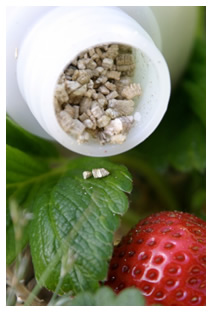 Where this balance works well is in our strawberries, where we release small populations of tiny almost invisible red mites to control the damage caused by its slower and smaller "cousin" the two-spotted spider mite. (At left, the red mites are the dust on the strawberry; the vermiculite is just the transporting agent.) The two-spotted spider mite occurs naturally and disperses with dust particles (now you know why should always drive slowly on a farm road), and thrives by feeding on the sap of young leaves, causing serious stunting and damage to both fruit and plants. The red mite - (Persimilis), which we have to purchase and release at a rate of 30,000-40,000 per acre once or twice over the course of of the season - is a 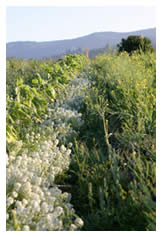 specialized predator of the two-spotted mite, feeding voraciously on both the adults and their eggs. We put a lot of effort into creating hedgerows (pics below) and otherwise protecting or enhancing our existing wild and native habitats, in order to encourage a year-round diverse population of beneficial insects in and around our fields. We also regularly plant flowering plants such as alyssum right in among the crops (especially among the brassicas and cucurbits) to lure beneficials, and to get a better handle on aphids which is one of our more difficult insect pests to control (aphids like the alyssum more than the crops). 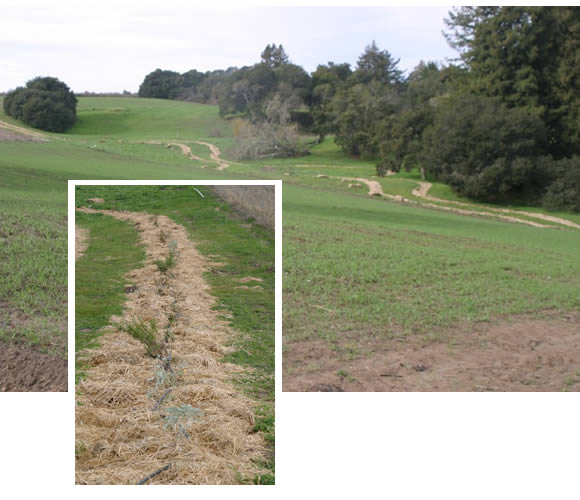 I think I know where Hollywood found inspiration for some of its more gruesome science fiction scenes (remember Alien?). Tachnid flies, for example, are a beneficial attracted by the sweet smell of the alyssum, and will control aphids by laying eggs on their body, which in turn develop into larvae and then parasitize the host insect by feeding within the body, sucking its body fluids until the aphid dies. (I hope no one minds the graphic description of how feeding takes place by some fellow creatures further down the food chain from us). :-) 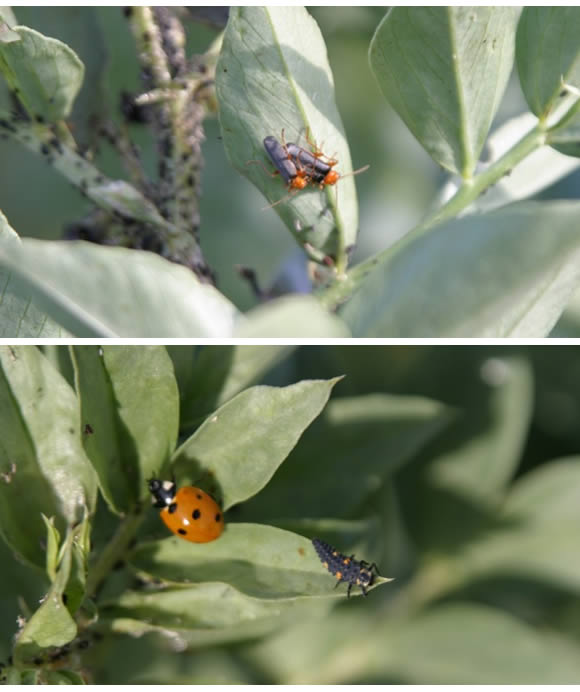 [closeup of beneficials going after the dreaded aphid; top: soldier beetles; bottom: ladybug and nymph] The health and vitality of a balanced food system and all its participating organisms is always dependent on a healthy soil. So often we dismiss soil as something inert that clings to our shoes and gets under our fingernails. However, dirt is at the heart of growing healthy and nourishing food. Soil scientists now recognize that the microorganisms in the soil - most of which are invisible to the naked eye - have intricate and fine-tuned relationships that, over the course of millions of years, have created the environment on which all plants and animals now exist. Worms, ants, termites, springtails, protozoa, fungi and bacteria ranging from the visible to the unimaginably minute perform important functions which drive most of the activity in the soil, most specifically the transfer of nutrients to plants. Here on the farm the way we feed and build these living soils is by making our own compost and applying it very generously at 15-20 tons per acre every season. In addition we grow cover crops, maintain an elaborate rotation of crops and cultivation practices, as well as apply soil amendments to improve tilth, replenish important micronutrients, and balance the soil pH. David Suzuki gives one of my favorite and most vivid descriptions of soil in his book Sacred Balance: "Imagine a giant tomato with a diameter of 70 meters (210 feet) but skin no thicker than that of an ordinary tomato. That thin outer layer corresponds to the fine wrapping of soil that covers the surface of our immense planet. The constant renewal of life on Earth occurs in that thin layer. We, like all other terrestrial life forms, depend on it, directly or indirectly, for our food." Of course there are also frustrations that come with growing food among a diverse population of healthy organisms. It is especially frustrating when those creatures who, just like us, have carved out their niche on top of the food chain, and who like to pick and choose the tastiest food around. Last weekend "Chella" our young Maremma, the dog we purchased to guard our livestock (mostly the sheep), decided to explore the chicken area. Her instinct to 'guard' was suddenly overwhelmed by the excitement to play chase and catch. Unfortunately she ending up devouring two of our egg-laying chickens. I admire Jim from TLC Ranch for his dedication to pasture raise his chickens; we are fortunate to get his eggs. Raising chickens outdoors on open fields takes a lot of experience and requires a relentless attention to keep predators away. It doesn't matter whether they are wild or domesticated - all seem to favor chicken on their menu. What I like about my job, though, is listening to what the land has to say, understanding what it can and cannot do, and continuously improving my own shortcomings by honoring the many visible (and even more abundant invisible) relationships within this food web from which we partake and are nourished.
- Tom |

The Joys of CSA Seasonality or What Fava Beans Mean to Me
~~~~~~~~~~~~~~~~~~~~~~~~~~~~~~~~~~~~~~~~~~~~~~~~ by member Mary Hall 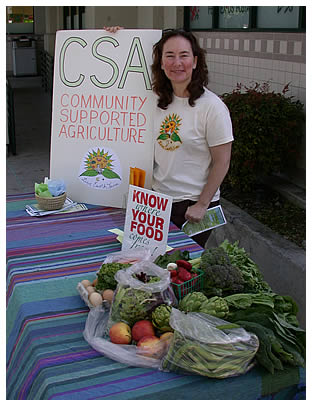 The weekend before last I
helped 'table' for Live Earth Farm at Willow Glen's "Earth Day on the Avenue",
and pretty much spent my time talking up the farm and spreading the good word
on CSAs in general. It was a lot
of fun talking food, organic gardening, and baby goats with whomever happened
to wander by. I was surprised at how the experience reminded me how much I
appreciate being a part of Live Earth Farm. It was particularly funny how so many conversations kept
circling me back to my new best friends: fava beans. It started with the
reporter from a local community newspaper, the Willow Glen Times. After getting the nuts and bolts
details out of the way, he asked, "Why do you do this? Why do you bother?" On the display table was a typical
springtime share. The quality of the produce was obvious, and I added the
standard spiel about how it's cheaper than what one would have to pay in a
high-ish end grocery store, and that it typically lasts much longer, and how
taking care of the earth takes care of us all, etc. Besides, I've learned about veggies that I'd never tried
before. "Like what for instance?"
the reporter asked. Well, like fava beans, for
instance. I had never had them
before I joined Live Earth Farm, and now they've become one of my very favorite
things. Besides being so delicious, they signify the beginning of spring, as
well as the beginning of the CSA season. I like that they're not readily available at most supermarkets (Cosentino's
being an obvious exception.) I
even like the fact that they're only available for a short time during the
year; it makes them seem just that much more special. That last bit set me off
on another tangent about the cyclical nature of life, holidays, and eating with
the seasons. (That poor reporter!) I pointed out that what he saw was more or
less what we were eating this month, but how in a couple weeks, we'll be
getting different veggies, then the plums will start showing up, and then come
the end of July and early August - it's tomato time! It hit me as I was talking with him that being part of a CSA
is like having a holiday every month or two, to wit: "Fava beans are better
than Christmas!" (Yes, I really did say that! The words were out of my mouth
before I could stop them.) I love being able to look
forward to delicious things coming my way throughout the year, reveling in them
while they're here, being sad to see them go, but not too sad though, because I
know that before too long there will be another delicious something wonderful
coming right around the corner... While the reporter was
still there, another passerby stopped to chat. She shared that she is a member of a different CSA, and her
pickup site is in Santa Clara. It was her second year doing this, so I asked her what she liked best
about it. Know what she said? "I'm so glad I discovered fava
beans! I love them! And I never would have known about them
if I hadn't joined the CSA!" Yes!! Proof that I'm not
the only fava bean freak out there! What do I do with my
lovely favas? I typically just shell, peel, then braise them into a puree that
goes on pasta or crostini (from Alice Waters' "Chez Panisse Vegetables"). This
week though, a friend scored a bunch more from another farm, so last night we
grilled them on the barbecue (olive oil, salt & pepper, then grilled over
med-high until charred and the pods begin to open). The leftover grilled favas are going on barbecued pizza with
goat cheese for tonight's supper (and to drink, we haven't yet decided:
sauvignon blanc or chardonnay?) Anyway, to Farmer Tom and
rest of the gang, I just want to say thanks. What a gift these monthly
'holidays' have become for me. And
many thanks to you, Debbie, for giving me the opportunity to reflect on all
this (and for all the cool recipes!). - Mary |
The little engine that could
~~~~~~~~~~~~~~~~~~~~~~~~~~~~~~~~~~~~~~~~~~~~~~~~ All you parents out there will appreciate this note sent in last week by member Colleen English... 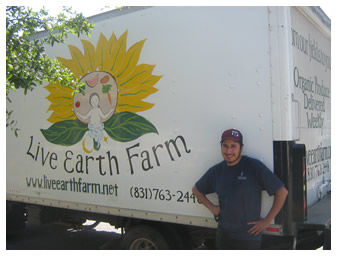 "This morning as I was returning to Scotts Valley after dropping my daughter off for school and I saw your truck headed over the hill. It reminded me of The Little Engine That Could "She was a happy little train for she had such a jolly load to carry. Her cars were filled full of good things for boys and girls." I read the story a lot as it is one of Claire's favorites. Now when I see your truck I think of it as a female, anyway, just made me smile and I thought I would share. Happy day to you! Colleen" |
Notes from Debbie's Kitchen
~~~~~~~~~~~~~~~~~~~~~~~~~~~~~~~~~~~~~~~~~~~~~~~~
Click here to go to the recipe database.
Mary Hall's unbridled enthusiasm for food and the CSA is absolutely infectious; I hope you are all ready to make pizza on the grill with fava beans! We talked after she wrote the above story, and so I got the skinny on her pizza-making and will share it with you here. I also heard from Loni Kao Stark again; I'd asked her for her 'slow-cooker' soup recipe made with leeks and chard and she was able to send it in time for this week's newsletter. We're getting escarole again, so I want to add something about that, and people are always looking for new ideas for radishes, I found a nice recipe for using fennel and arugula in my archives, and I made the crispy leeks again, this time documenting with pictures... so it's gonna be a rich full recipe section this week! - Debbie
Mary Hall's Grilled Pizza with Favas and Chevre
compiled by Debbie
Of course for starters you'll need a pizza dough recipe, so you have two choices: you can either use Debbie's Pizza Dough Recipe or the one Mary used, which was from an extensive Italian food recipe and bread baking site called 'The Artisan'. [It is an older site which uses frames, so you need to scan the left-hand sidebar and look for the link entitled "Basic Pizza Dough", which is further down the list].
Other ingredients would be:
Cooked and peeled (skinned) fava beans
chevre
green garlic
olive oil
salt
[optionally you could add just a tich of herbs... oregano maybe? or thyme?]
Start by making some green garlic-infused olive oil (just chop up a bunch of green garlic and let it sit in olive oil to infuse). Do this before you start your pizza dough, so that it can get good and garlicky. [Or you can make this the day before; I don't think you can over-infuse the oil!]
Mary says to make small, personal-sized pizzas (no more than 8" across) so the
dough doesn't fall through the grill [I asked her about that; she said it wasn't
a problem] and it is generally easier to work with. If you put them onto a piece
of foil (make sure the bottom is well floured so it doesn't stick), then you
can transfer them quickly.
Pre-cook the crusts on a hot BBQ grill [she used her gas grill 'high as it would go']. Cook them very quickly on one side for 30 seconds to a minute - not longer than a minute. You want grill marks, but not black.
Take them off the grill, turn the grill down to medium-to-low.
Flip the crusts over, and put the toppings on the pre-cooked side: lightly oil
the crust with some of the garlicky oil, especially the edges, she says. Then
coarsely mash the favas and spread or scatter on top; sprinkle bits of chev
on top of the favas, then top that with [an optional sprinkling of herbs, salt
to taste, and] a teaspoon or two of the garlic oil mixture, aiming to get more
garlic than oil. She says for barbecuing it works best if the topping layers
are really thin [so, maybe more like a grilled foccacia with a thin spread of
goodies on top?].
Return prepared pizzas to the grill to finish cooking. This will take anywhere
from 5 to 10 minutes, depending on how thick your crust is, how thick your toppings
are, and how hot your grill is (watch them; you don't want them black on the
bottom!). If the dough looks done but the topping not, she says you can remove
them from the grill and finish them in the oven [preheat your oven to 450 or
500 if you anticipate doing this].
Next up, Loni Kao Stark's slow-cooker leek and chard pea soup:
'Aromatherapy for the Soul' Pea, Leek and Chard Soup
Loni provides extensive instructions and pictures on her website, so just click on her picture below to go there and enjoy! Note that you'll need a slow-cooker and an immersion blender to make this soup.
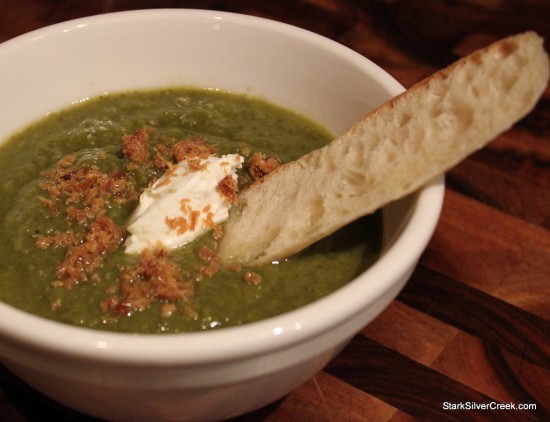
Pan-browned Escarole
This one's very simple. In essence, escarole is a bitter green, just like radicchio, so I decided to cook it the same way and it came out just as delish! My escarole head was not that large, so I cut it in half (leave the root end intact to hold the leaves together; you can thinly trim off any browned part), rinsed it well down in the crevices at the base of the leaves (where dirt can reside), then spun it well in my salad spinner.
Remove escarole from spinner, drizzle with a little olive oil and sprinkle with salt.
Heat a cast iron (or similar heavy-bottomed pan) and get it pretty hot, then add olive oil, then fit the two halves into the pan cut side down, gently pressing with a wide spatula to flatten as it cooks. Turn the heat down to medium or so, and allow to brown. Depending on the thickness of the escarole you're using (and whether it is frisee or the broadleaf kind) this could be as short as a minute, to as long as 3 or 4 minutes. You can lift it up and peek, or flip it over briefly then flip it back.
Once browned on the first side, flip it over, drizzle in a little balsamic vinegar, and press it and cook it until the greens are wilted and cooked, and lightly to moderately browned. That's it!
What's nice about this recipe is that if you are feeling overwhelmed with this big head of unknown stuff, it cooks way down in volume (as do most greens when cooked), and so it uses it all up in one fell swoop! One medium-sized head of escarole served two.
Arugula Salad with Oranges and Caramelized Fennel
modified from an undated Bon Appetit clipping
serves 4
1 large fresh fennel bulb, trimmed, cut vertically into 12 wedges with some core attached [to hold it together while cooking]
3 fresh thyme sprigs
3 tbsp. extra-virgin olive oil, divided
2 tbsp. Sherry wine vinegar
1/2 tbsp. Dijon mustard
2 oranges, all peel and white pith cut away, halved vertically, thinly sliced crosswise
Four large handfuls of fresh arugula
Preheat oven to 400 degrees F. Combine fennel wedges, thyme, and 2 tbsp. oil in a large bowl; toss to coat. Arrange fennel, cut side down, on a large rimmed baking sheet. Sprinkle with salt and pepper. Roast until fennel is tender and brown, turning once, about 40 minutes. Remove from oven, discard thyme sprigs, and let rest and come to room temperature.
Whisk vinegar, mustard, and 1 tbsp. oil in a large bowl. Season dressing with salt and pepper. Add fennel, orange slices, and arugula. Toss to coat. Transfer salad to a large shallow bowl and serve.
People are always wondering what the heck to do with radishes. I for one just like having them around to add color to my plate, especially in the spring when we're getting a lot of green. But they are a lot more versatile than most people think. Farm apprentice Molly Culver sent me this great link from this week's New York Times; several wonderful radish recipes ensue, so I encourage you to click and read!
Relishing Radishes
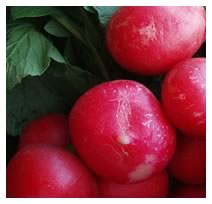 What's interesting about this link is that it also talks about making radish sandwiches, something that, if you've been a member of our CSA for awhile, is a thing I learned about from another member years ago and have been a total fiend for ever since. Also interesting is how it calls for a good brown bread, like pumpernickel (whereas the version I've made up until now has always called for sweet French baguette). In the NYTimes recipe it calls for using French Breakfast radishes, but really, you can use them or regular red radishes interchangeably. What's interesting about this link is that it also talks about making radish sandwiches, something that, if you've been a member of our CSA for awhile, is a thing I learned about from another member years ago and have been a total fiend for ever since. Also interesting is how it calls for a good brown bread, like pumpernickel (whereas the version I've made up until now has always called for sweet French baguette). In the NYTimes recipe it calls for using French Breakfast radishes, but really, you can use them or regular red radishes interchangeably.
Without further ado, here's the link to the NYTimes story!
Lastly, I finally made my 'crispy leeks' once again, this time carefully documenting with pictures. After making them once but with too much salt, and a second time burning them (!), the third time was the charm:
Crispy Leeks, step-by-step with pictures!
3 to 4 big leeks
olive oil
salt
Preheat oven to 400 degrees F and have two racks in your oven, one up top, and one in the middle. You can use as much of the white and light-green part of the leek as you can get; just trim the root end away and cut off the dark green leaves. Be sure to check between the layers at the leaf-end of the leeks for dirt, and wash away then blot dry as necessary. Cut leeks in half lengthwise, then into 2-inch-ish segments. If the leeks are big, cut these pieces in half again lengthwise.
Separate the leeks into their individual layers and accumulate in a bowl. Drizzle lightly with olive oil and toss well to coat. Spread leaves in a single layer (don't crowd them) on two baking sheets. Sprinkle modestly with salt.
Put both pans in the oven (one on the upper rack, one on the lower) and bake 10 minutes, then swap the pans top/bottom (and if you can, rotate them 180 degrees too - my oven is hotter towards the door end, so this helps even the cooking). Bake another 8 minutes and then check on them. If some pieces are done and some are not, with tongs or a spatula, remove the done ones to a bowl and return pan(s) to the oven for another minute or two, keeping a close eye so they don't burn.
They should be light to medium brown and crispy when done. Totally addictive as an appetizer-snack like popcorn or potato chips!
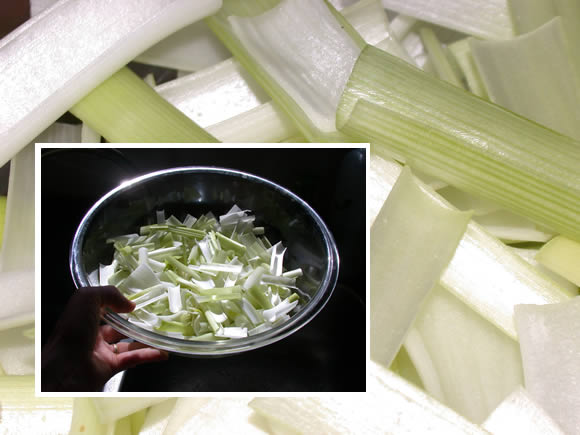
Step 1: cut leeks in segments and separate into leaves
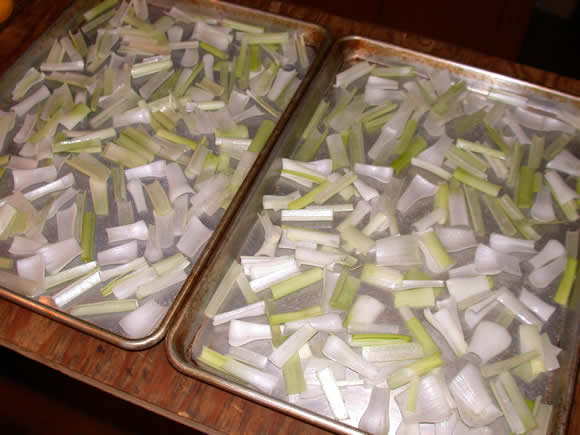
Step 2: spread in an uncrowded single layer on baking sheets
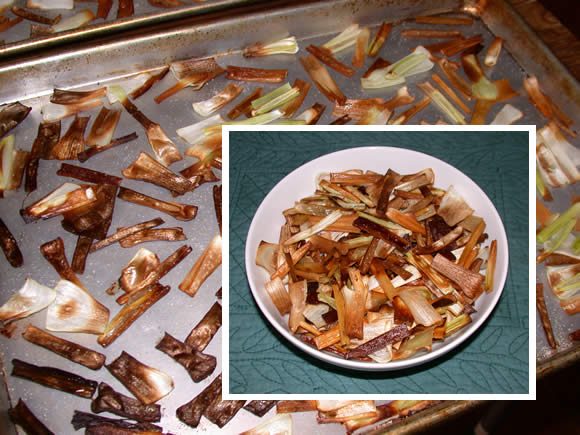
Step 3: bake until brown and crispy!
|
|
2010 CALENDAR
~~~~~~~~~~~~~~~~~~~~~~~~~~~~~~~~~~~~~~~~~~~~~~~~
Visit our website's calendar page for more details, including photos and videos of past events. This is a great way to get the flavor of what it is like visiting the farm!
Live Earth Farm Discovery Program for WEE ONES
3rd Tuesday of every month, 10:30am - Noon
(free for children 0 - 3 yrs; $10 - $15 per adult)
 Mothers, fathers, grandparents, caretakers of any kind... bring the babe in your arms to experience the diversity of our beautiful organic farm here in Watsonville. We will use our five senses to get to know the natural world around us. The farm is home to over 50 different fruits and vegetables, chicks, chickens, goats, piglets, and the many wild members of the Pajaro watershed. Mothers, fathers, grandparents, caretakers of any kind... bring the babe in your arms to experience the diversity of our beautiful organic farm here in Watsonville. We will use our five senses to get to know the natural world around us. The farm is home to over 50 different fruits and vegetables, chicks, chickens, goats, piglets, and the many wild members of the Pajaro watershed.
For more information, contact Jessica at the LEFDP office: (831) 728-2032 or email her at lefeducation@baymoon.com.

Happy Girl Kitchen's 2010 Workshop Schedule at LEF
(all workshops are from 10am to 3pm and include an organic lunch, as well as take-home items from what is made that day!)
March 6 (Saturday) - Fermentation (sauerkraut, kimchee and kombucha)
April 10 (Saturday) - Cheese and kefir
June 6 (Sunday) - Cherries and spring berries
July 10 (Saturday) - Apricots, strawberries and blackberries
September 12 (Sunday) - Heirloom tomatoes
October 2 (Saturday) - Pickles
Contact Jordan if you have any questions
jordan@happygirlkitchen.com
http://www.happygirlkitchen.com
Community Farm Days Schedule
(All Community Farm Days are Saturdays unless otherwise noted.)
March 20 - Sheep to Shawl
May 29 - Three sisters planting in the field! Help sow pumpkins, corn, and beans
June 19 - Summer Solstice Celebration and Strawberry U-pick
July 3 - Apricot and Strawberry U-pick
July 12 thru 16 - Summer Celebration Art on the Farm Day Camp!
Aug 28 - Totally tomatoes. From farm to fork, cooking with tomatoes and making farm-fresh cheese. Also U-pick raspberry and tomato day!
Sept 25 - LEFDP Second Annual Fundraiser
Oct 23 - Harvest Celebration and Apple U-pick
|
|